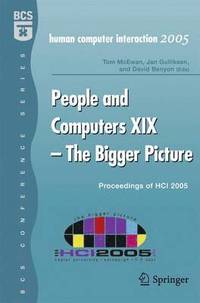
- Format
- Häftad (Paperback / softback)
- Språk
- Engelska
- Antal sidor
- 510
- Utgivningsdatum
- 2005-09-01
- Upplaga
- 2006 ed.
- Förlag
- Springer London Ltd
- Medarbetare
- McEwan, Tom (ed.), Gulliksen, Jan (ed.), Benyon, David (ed.)
- Illustratör/Fotograf
- FotosUIllustr 276 Abb 53 Tab
- Illustrationer
- 138 Illustrations, black and white; XVIII, 510 p. 138 illus.
- Dimensioner
- 232 x 158 x 33 mm
- Vikt
- Antal komponenter
- 1
- Komponenter
- 1 Paperback / softback
- ISBN
- 9781846281921
- 781 g
People and Computers XIX - The Bigger Picture
Proceedings of HCI 2005
- Skickas från oss inom 7-10 vardagar.
- Fri frakt över 249 kr för privatkunder i Sverige.
Passar bra ihop
De som köpt den här boken har ofta också köpt Co-Intelligence av Ethan Mollick (häftad).
Köp båda 2 för 2396 krKundrecensioner
Fler böcker av författarna
-
Designing User Experience
David Benyon
-
Användarcentrerad systemdesign : en process med fokus på användare och användbarhet
Jan Gulliksen, Bengt Göransson
-
Digitaliseringen och arbetsmiljön
Bengt Sandblad, Jan Gulliksen, Ann Lantz, Åke Walldius, Carl Åborg
-
Human-Centered Software Engineering - Integrating Usability in the Software Development Lifecycle
Ahmed Seffah, Jan Gulliksen, Michel C Desmarais
Innehållsförteckning
H HCI at the Human Scale.- Looking At the Computer but Doing It On Land: Childrens Interactions in a Tangible Programming Space.- The Usability of Digital Ink Technologies for Children and Teenagers.- PROTEUS: Artefact-driven Constructionist Assessment within Tablet PC-based Low-fidelity Prototyping.- The Reader Creates a Personal Meaning: A Comparative Study of Scenarios and Human-centred Stories.- What Difference Do Guidelines Make? An Observational Study of Online-questionnaire Design Guidelines Put to Practical Use.- Designing Interactive Systems in Context: From Prototype to Deployment.- Using Context Awareness to Enhance Visitor Engagement in a Gallery Space.- Engagement with an Interactive Museum Exhibit.- User Needs in e-Government: Conducting Policy Analysis with Models-on-the-Web.- Fit for Purpose Evaluation: The Case of a Public Information Kiosk for the Socially Disadvantaged.- A Visuo-Biometric Authentication Mechanism for Older Users.- C HCI in the Greater Cultural Context.- A Computer Science HCI Course.- Use and Usefulness of HCI Methods: Results from an Exploratory Study among Nordic HCI Practitioners.- Building Usability in India: Reflections from the Indo-European Systems Usability Partnership.- Visualizing the Evolution of HCI.- I thought it was terrible and everyone else loved it A New Perspective for Effective Recommender System Design.- Rich Media, Poor Judgement? A Study of Media Effects on Users Trust in Expertise.- Cultural Representations in Web Design: Differences in Emotions and Values.- Interaction Design for Countries with a Traditional Culture: A Comparative Study of Income Levels and Cultural Values.- Researching Culture and Usability A Conceptual Model of Usability.- I HCI Down at the Interface.-Distinguishing Vibrotactile Effects with Tactile Mouse and Trackball.- HyperGrid Accessing Complex Information Spaces.- Mixed Interaction Space Expanding the Interaction Space with Mobile Devices.- Static/Animated Diagrams and their Effect on Students Perceptions of Conceptual Understanding in Computer Aided Learning (CAL) Environments.- Media Co-authoring Practices in Responsive Physical Environments.- Cognitive Model Working Alongside the User.- Revisiting Web Design Guidelines by Exploring Users Expectations, Preferences and Visual Search Behaviour.- Comparing Automatic and Manual Zooming Methods for Acquiring Off-screen Targets.- Forward and Backward Speech Skimming with the Elastic Audio Slider.- Design Patterns for Auditory Displays.- Closing Keynote of HCI2005: The Bigger Picture.- Grand Challenges in HCI: the Quest for Theory-led Design.
Du kanske gillar
-
Elon Musk
Walter Isaacson
Inbunden


